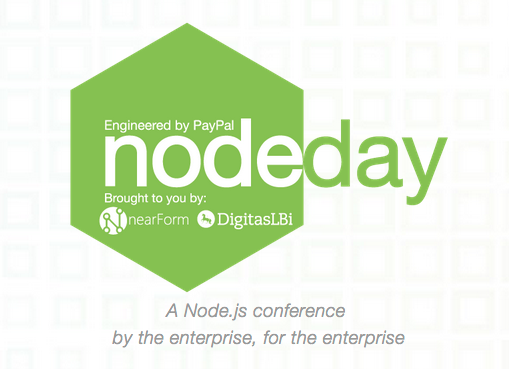Node 0.12.5, 0.10.39, io.js 2.3.1
Two new releases of Node just came out. Both releases fix OpenSSL security issues, but 0.12.5 also includes updates for uv and npm.
io.js 2.3.1 was also released this week. One of the big changes in this release is performance improvements for require:
module: The number of syscalls made during a require() have been significantly reduced again (see #1801 from v2.2.0 for previous work), which should lead to a performance improvement (Pierre Inglebert) #1920.
This sounds very nice for large projects.
NodeDay

NodeDay is a conference being held in London on 26th June (this Friday), for free! Speakers include Lin Clark, who writes npm’s excellent blog posts, and programmers from the BBC, Red Hat, and other companies that are using Node for interesting things.
nodeday is a Node.js conference by the enterprise, for the enterprise. Now in its second year, this one-day industry conference brings together people from companies that have adopted or are planning to adopt Node.js, and focuses on the issues that these companies face. It gives participants a forum to discuss and share their experiences with Node.js, share advice, tips and tricks, and drive forward both the technology and the community.
I apologise for not writing about this sooner, but I only just found out about it! If you have conferences you want me to cover on DailyJS, you can use the contact forms or message me on Twitter (@alex_young).
I really wanted to go to NodeDay but I can’t make it this time.
Apey Eye
Filipe Sousa sent in Apey Eye (GitHub: https://github.com/glazedSolutions/apey-eye, License: MIT, npm: apey-eye):
Apey Eye is an Object-Resource Mapping Node.js API framework that uses next-generation JavaScript features that can be used today, like Classes, Decorators and async/await for maximum expressiveness.
This is a framework for building data layers that map directly to REST APIs. It’s a bit like ORM for HTTP. It comes with base classes for routing, REST resources, models, and validation, and the models can serialise data to RethinkDB. To talk to other databases a new base model class would have to be written.
Thanks to ES6, the model syntax is very clean:
let Model = ApeyEye.Model;
class MyModel extends Model {
constructor() {
super(async function() { (...) });
}
static async fetch() { (...) }
static async fetchOne() { (...) }
async put() { (...) }
async patch() { (...) }
async delete() { (...) }
}
To me this looks like C# without the extra syntax for strong typing. The validation API looks similar to what you might have seen before with modules like Mongoose.
I like the idea of object-resource mapping at the HTTP level. In Node web apps we seem to spend a lot of time thinking about HTTP servers and APIs, so this feels like it could reduce the amount of boilerplate required to interface from that step to the database layer.
Source: DailyJS
